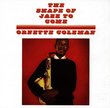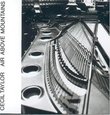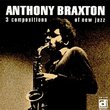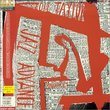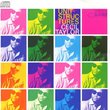| All Artists: Cecil Taylor Title: Conquistador Members Wishing: 1 Total Copies: 0 Label: Blue Note Records Release Date: 3/23/2004 Album Type: Extra tracks, Original recording remastered Genres: Jazz, Pop Style: Avant Garde & Free Jazz Number of Discs: 1 SwapaCD Credits: 1 UPC: 724359084022 |
Search - Cecil Taylor :: Conquistador
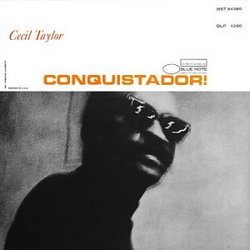 | Cecil Taylor Conquistador Genres: Jazz, Pop
Personnel: Cecil Taylor: piano Bill Dixon: trumpet Jimmy Lyons: alto sax Henry Grimes, Alan Silva: bass Andrew Cyrille: drums |
Larger Image |
CD DetailsSynopsis
Album Description Personnel: Cecil Taylor: piano Bill Dixon: trumpet Jimmy Lyons: alto sax Henry Grimes, Alan Silva: bass Andrew Cyrille: drums Similar CDs
|
CD ReviewsThe other half of Cecil's '66 Blue Note sessions.. Finally! Matt Stephens | USA | 08/17/2004 (5 out of 5 stars) "1. Conquistador 17:54 2. With (Exit) 19:20 3. With (Exit) 17:24 Cecil Taylor, piano Bill Dixon, trumpet Jimmy Lyons, alto sax Henry Grimes, bass Alan Silva, bass Andrew Cyrille, drums If I didn't know better, I'd think this music was from the same session as Unit Structures, but it isn't. It's got roughly the same group (there's a different trumpet player and only one sax). For me, the real joy of this record (and any of Cecil's other recordings from this period) is the rhythm section. Andrew Cyrille is to me one of the truly great and innovative drummers of that time. The bass duo of Henry Grimes and Alan Silva is incredible as well. Grimes strums and rumbles in the background while Silva shades and colors the music with his unbelievably high-pitched bowed tones, formally called "arco bass." And of course, Cecil Taylor, one of the greatest musicians ever. And I don't mean among the other two-thousand "greatest musicians ever;" I mean that he is probably one of the top 10 greatest musicians who ever lived. Other musicians have even said that he was greater than Stravinsky. So you really can't go wrong with a set like this if you are a fan of avant-garde jazz, or even if you just appreciate creative & innovative music. Bill Dixon and Jimmy Lyons play wonderful melodies and solos throughout the record (Dixon's solo on the alt. take of "With (Exit)" is particularly interesting). Although it's not easy listening for people who haven't been exposed to free music before, this is a must-have for Cecil Taylor fans and avant-garde jazz fans in general. The original album consisted of two side-length tracks (the first two on the CD). An alternate take of "With (Exit)" has been added for our listening pleasure. Although it is a wonderful song, it doesn't differ too much from the master take. This album has been out of print for a very long time; it was only just reissued by Blue Note in 2004. Recorded in 1966, Conquistador came from one of the two only sessions that Taylor had with Blue Note (the other one, only a few months earlier, produced Unit Structures). An earlier Taylor album, Jazz Advance, has been reissued by Blue Note, but it was originally recorded for an independent label. At any rate, it's an absolute joy to have the other half of his Blue Note sessions. Both Conquistador and Unit Structures include the basic nucleus of Taylor's working group: Jimmy Lyons, Andrew Cyrille, Henry Grimes, and Alan Silva. (The live album Student Studies, recorded in late 1966, featured Lyons, Cyrille, and just Silva on bass.) This was pretty much Taylor's main band for a very large portion of his career. Lyons joined in 1960 and stayed until his death in the 1980s. Cyrille joined in 1964 and stayed until the mid-70s. I believe Grimes joined in 1961, but I'm not sure when he left. I'm pretty sure that Silva just worked with Taylor in the 1960s. Anyhow, many Taylor fans, including this one, believe that this was his best group. The title track begins with a few characteristic atonal piano flourishes, followed by a brief statement from the horns. Listen to what Grimes is doing here; at first it seems that he's just playing random notes, but it soon becomes apparent that he's playing an out-of-time repeated pattern. I swear, if I had a free-jazz group, this is the man I would want on bass. He had such a cool touch. This short section gives way to a Jimmy Lyons solo, in which he explores atonality without abandoning the scale he's apparently hearing in his head. Cyrille is playing freely, but he still hints at the time; it's a kind of loping, uneven pulse. And of course Cecil is just thrashing underneath it all. This fades into a slow, drawn out section for Dixon to come in and play a short but beatifully lyrical solo. I love the contrast of the two horns' solo sections. After Dixon finishes up, the rhythm section briefly develops a new groove, with Silva bowing high notes on top of it. The horns state a different theme, which is more tonal and organized. Cyrille suggests a latin feel here. The next 5 or 6 minutes belongs to Cecil, who does an incredible solo here. Keep in mind that he means to hit all the notes he does; it may sound like he's just randomly hitting the piano, but he is really thinking about what he's playing. A Taylor solo is sort of like an odd dream-you have no clue what's going to come next. Silva slithers in and out with more arco bass. During all of this, Grimes sounds like an earthquake. Cecil wraps up his solo and fades down a bit and Silva solos for a bit on bowed bass. Cecil comes back in before the horns restate the second theme. Then the entire group drops out except for Grimes and Silva, who play a great duet. Silva puts down his bow and plays pizzicato, exploring the same idea that Lyons finished his solo with. Notice how different the two basses sound; something tells me that Silva was playing a smaller bass. His notes just sound higher-pitched than Grimes, even though they're playing in the same register. The rest of the group comes back in, the horns restate the first theme, and the tune ends. "With (Exit)" is fairly similar in structure to the title track, but it is certainly a unique tune nevertheless. It opens with a wash of bowed bass and piano, slow and legato. Cyrille adds bits of color here and there. The horns state what may be the coolest (and creepiest) Taylor theme; it brings to mind a nursery rhyme of some sort. I could picture an into like this being in a thriller movie. If you like the beginning of this tune, you might want to check out "Student Studies" (mentioned above). After the theme, the rhythm section just kind of trips out for a few minutes. Lots of interplay between Cecil and Silva. Dixon eventually comes in and plays a really far out solo. He seems to be responding to Cyrille, whose quick, fluttering brushes make for some great tension. Dixon's short, atonal outbursts build and build, and you think that he is just going to go crazy, but then he steps out and the momentum changes. Cyrille kicks it up a notch and Lyons comes in, again with Cecil thrashing and cursing underneath. Next comes Cecil himself. Do I really need to describe what happens here? A Cecil Taylor solo is experienced, not talked about. After Cecil is finished blowing our minds, the theme is stated again and the group takes it out. The alternate take of "With (Exit)" is basically the same as the master structure-wise, except I think that Dixon does a better solo on the alternate. Conquistador could definitely be considered one of Cecil's best albums. He did a lot of work, and much of it differs from what the average person is used to. Conquistador could be an ear-shattering but revelatory and enlightening experience if the listener is not aware of what is to come. However, if you dig Cecil and you haven't heard this, then you're in for a trip." Cecils best!!! Jakob Hellberg | Gothenburg, Sweden | 03/26/2004 (5 out of 5 stars) "Apparently, Blue Note has finally re-released this album again (it has been available on cd before but was several years ago). The band is similar to the one on "Unit Structures" in that it features Cyrille, Silva, Grimes and Lyons. Added to this group is the incredible trumpeter Bill Dixon who really adds to the magic of this album. His style is introverted, moody and RELATIVELY laid-back. This was a great contrast with the rest of the group and it was a stroke of genius to include him on the album.There's only two songs on the album; the title track and "With (Exit). Both those songs are less dense and complicated than the compositions on "Unit Structures" which makes this a great first-buy for new-comers to cecils later (post-62) works. The first song, "Conquistador" starts with a theme which is followed by a typically intense (but logical) Lyons solo. If you listen to Cecils piano in the background you can hear that there are easily recognizable tonal centers which isn't always the case with his music. After Lyons comes a beautiful, laid-back section where Dixon plays a lyrical trumpet solo. This leads into the "real" theme which is far more melodic in the conventional sense than Taylor usually is. Cecil then plays a long, incredible piano-solo backed by "african"-sounding percussion. The song ends with a bass-piano section and a recapitulation of the first theme. Incredible stuff. The other song, "With (exit)" is my favourite Cecil Taylor composition. It starts off with another catchy and beautiful theme that goes through a syncopated section and a more intense one. The solos are basically explorations of the various moods of the theme. First a beautiful piano-basses section, then a trumpet solo over syncopated rhytms followed by a long, intense alto solo. Then follows one of the best piano solos I've ever heard where Cecil goes from ethereal, laid-back passages to screaming intensity and back to the theme again. The whole number doesn't sound disjointed at all; it flows seamlessly from section to section. This is one of the best "avant-garde" jazz albums ever made and a perfect way to start your Cecil Taylor collection!!!" I agree--Cecil's Best Thor Furbeck | maryland usa | 09/14/2004 (5 out of 5 stars) "I've got alot of Cecil's stuff, but I have to agree that Conquistador may very well be Cecil's masterpiece. It really is better than Unit Structures, and had you told me that before I heard it I wouldnt have believed you. Also thanks to Rudy Van Gelder, it sounds much better too. Dont hesitate to get this one, it's excellent."
|

 Track Listings (3) - Disc #1
Track Listings (3) - Disc #1